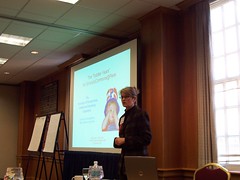Mood:
I've been forgetting to sign my posts so I will do it at the start and re-edit the others.
Notes from Christina Pikas

Why get into this business anyway?
(partial list, changes over discipline and over time)
- access to information, highlight student work, stable archives
- specific desire of a campus unit (at Penn, Eng.)
- campus climate (centralized, funding structure, top down vs. grassroots, relationship between IT/library/archives)
- improve visibility/stature of academic research and scholarly activity
Scope and Nature
- short term, where to start, pilot, seeding the repository
- long term, across campus, cooperation
- pilot: the best work from the School of Engineering & Applied Science, recent work, with the endorsement of the leadership
Implementation
- oversight (IT, cataloger, administration, license/copyright person from serials)
- they chose the PQ product to get a turn-key solution with less burden on library and university IT
- f/t only
- they took on the burden of copyright compliance (to encourage submissions without reading through and complying with extensive publisher-specific policies)
(according to Stevan Harnad, you can just put everything up, and make f/t only available to the institution where required, then provide author e-mail and suggest that outsiders send e-mail asking for e-print, then author can send an e-print from the repository)
Operations -- getting content
- submit via e-mail
- harvesting faculty web pages
- alerts on relevant databases, e-mail authors
Going public
- timed the launch (not over break)
- marketed via demos, write-ups, mailings, links, share statistics
- registered with search engines
Assessment
daser2005
Updated: 12/5 to add tag and picture
Posted by asistdaser
at 12:40 PM EST
Updated: Monday, 5 December 2005 1:01 PM EST
